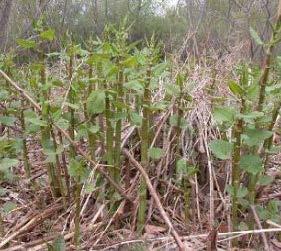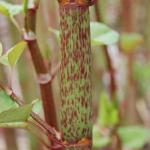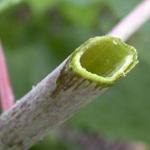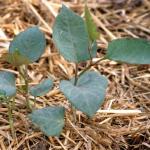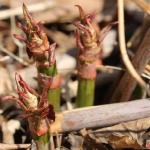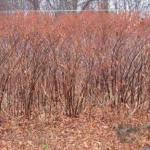Japanese Knotweed 2022
Japanese Knotweed is an invasive, herbaceous, perennial geophyte. It is listed by the Invasive Species Specialist Group (ISSG; www.issg.org) as one of the 100 worst invasive alien species in the world. Japanese Knotweed is native to Asia, but was brought to the US in 1877 as an ornamental plant (herbarium record, University of Massachusetts Amherst, Amherst, Massachusetts, USA). It can be found in riparian areas and habitats strongly disturbed by man since it prefers nutrient-rich habitats where water is readily available (Beerling et al., 1994). In cranberry bogs in Massachusetts, Japanese knotweed has been more commonly found in bog ditches rather than on the bog itself (Sandler pers. comm.).
Taxonomy
Japanese Knotweed’s classification has been debated by taxonomists so it can be referred to by various different scientific names including Fallopia japonica, Pleuropterus cuspidatus, Pleuropterus zuccarinii, Polygonum cuspidatum var. compactum, Polygonum zuccarinii, and Reynoutria japonica. In Europe, researchers are split between Reynoutria japonica and Polygonum japonica, while in North America researchers typically use P. cuspidatum (Global Invasive Species Database, 2021). Japanese knotweed goes by a variety of common names as well including sally rhubarb, German sausage, peashooter plant, donkey rhubarb, Japanese bamboo, crimson beauty, reynoutria fleece flower, Japanese fleece flower, Mexican-bamboo, Japanese polygonum, kontiki bamboo, itadori, and renouée du Japon (Global Invasive Species Database, 2021).
Identification
Japanese knotweed resembles bamboo due to the appearance of its stem, which is similar to bamboo in that it is jointed, hollow, and stout (Uva et al., 1997). The leaves distinguish Japanese knotweed from bamboo since they are large and round with pointed tips unlike bamboo leaves that are narrower (Dwelley, 1973). Japanese knotweed produces white-green flowers in late summer. These flowers are small and arranged in panicles that are 10-13 cm (4-5 inches) in length. Dark brown, triangular seeds are enclosed in three-winged calyxes. Single seeds are enclosed in each calyx but seedlings are rarely encountered; rather, new shoots emerge in early spring from rhizomes. These new shoots are a reddish color and can emerge through thick mediums, such as heavy mulch and even asphalt. New shoots are also edible (Uva et al., 1997).
Japanese knotweed can grow up to 3 meters (9-10 feet) tall but their rhizomes can extend up to 60 meters (200 feet) (Gleason and Cronquist, 1991; Somers et al., 2008). A dense canopy can form in the summer, which prevents other species from growing below. Additionally, stem litter can limit the coexistence of other plant species with Japanese knotweed even after they die back in the winter (Beerling et al., 1994). New shoots will emerge from rhizomes in the spring. Monocultures of Japanese knotweed have been seen after stands are established. It has been observed that the presence of Japanese knotweed reduces local species diversity, providing evidence that it can suppress forest regeneration (Aguilera et al., 2010).
Management
In MA cranberry production, Japanese Knotweed is considered a low priority weed because it is more commonly found on the edges of bog ditches, and areas surrounding beds rather than as a weed within production areas, although it is occasionally found on new plantings and on established beds. If found growing in production areas, it would then be considered a high priority weed and would need to be dealt with immediately. The best way to control Japanese knotweed is to dig up small plants or wipe them with glyphosate before stands are established to prevent further spread (Sandler and Ghantous, 2021). Once colonies are established, it is much more difficult to eradicate. For larger plants, mowing and cutting can be effective if used in combination with an herbicide. Removing the above ground section of the plant in early June and allowing stalk regeneration before treating improves success of chemical treatment. Smothering will also make chemical treatment more effective because it weakens rhizomes (Cygan, 2018).
References
Aguilera, A.G., Alpert, P., Dukes, J.S., and Harrington, R. 2010. Impacts of the invasive plant Fallopia japonica (Houtt.) on plant communities and ecosystem processes.” Biological Invasions 12:1243-1252.
Beerling, D.J., Bailey, J.P., and Conolly, A.P. 1994. Fallopia japonica (Houtt.) Ronse Decraene (Reynoutria japonica Houtt.; Polygonum cuspidatum Sieb. & Zucc.). Journal of Ecology 82(4):959-979.
Cygan, D. 2018. Preventing the spread of Japanese knotweed Reynoutria japonica (aka: Fallopia japonica, Polygonum cuspidatum). New Hampshire Department of Agriculture, Markets and Food. https://www.agriculture.nh.gov/publications-forms/documents/japanese-kno....
Global Invasive Species Database (2021) Species profile: Polygonum cuspidatum. Downloaded from http://www.iucngisd.org/gisd/species.php?sc=91 on 12-07-2021.
Gleason, H.A. and Cronquist, A. 1991. Manual of Vascular Plants of Northeastern United States and Adjacent Canada. 2nd Edition, New York Botanical Garden, pp. 135–139.
Dwelley, M.J. 1973. Trees and Shrubs of New England, Down East Books, Camden, ME. 224 p.
Sandler, H.A. and Ghantous, K.M. 2021. Weed Management 2021-2023, in: Cranberry Chart Book 2021-2023 Management Guide for Massachusetts, edited by K.M. Ghantous, M.M. Sylvia, and D. Gauvin. University of Massachusetts Amherst. https://ag.umass.edu/cranberry/publications-resources/cranberry-chart-book .
Somers, P. Kramer, R., and Brumback, B. 2008. A Guide to Invasive Plants in Massachusetts. Second Edition. Massachusetts Division of Fisheries and Wildlife.
USDA, NRCS. 2021. The PLANTS Database. National Plant Data Team, Greensboro, NC. http://plants.usda.gov.
Uva, R.H., Neal, J.C., and DiTommaso, J.M. 1997. Weeds of the Northeast, Comstock Publication Associates, Cornell University. 480 pp.
Phoebe Antonio, Katherine Ghantous, and Hilary Sandler, February 2022

